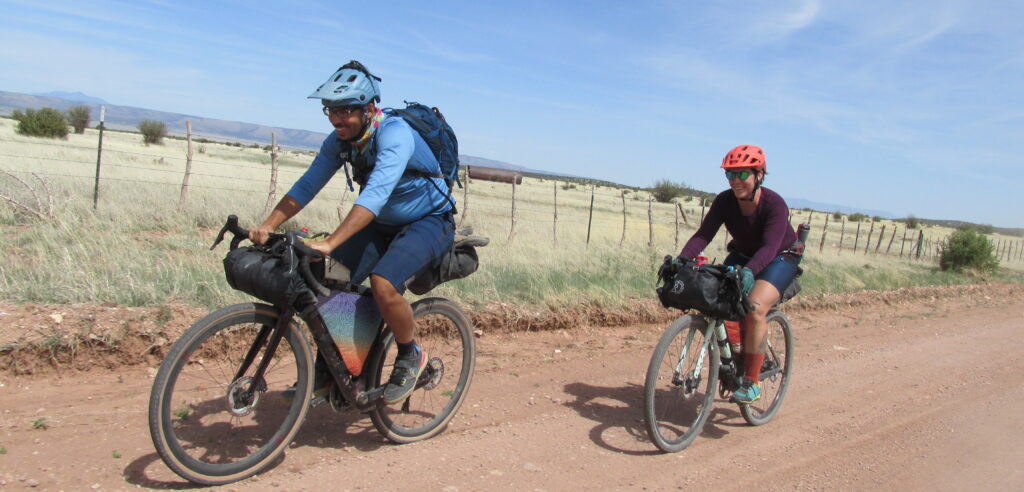
General:
– Aerobars and their accessories are allowed
– LEAVE NO TRACE. If you carry it in, carry it out. The goal is to keep the area we are rolling through better than we found it.
– Follow all traffic laws. You must use lights when riding at night on any public road.
– Unless you can actually see another rider coming behind you, always close a gate you open
– No trespassing. Please respect private property.
Popular ways to ride the multi day courses and accepted definitions from other similar rides:
Self-Supported Bikepacking (example: Tour Divide)
Solo:
– Individual caches (food, water, gear, etc) are not allowed.
– No support crews.
– No motorized transport along the route.
– Unplanned support from a fellow rider is allowed.
– Gas stations, restaurants, hotels, campgrounds, and any other commercial services along the route are fair game as long as they are not pre-arranged.
– In the event of a serious mechanical issue that renders a bike unrideable, a rider may hitchhike by motor vehicle in ANY direction to repair the problem. A rider may also receive assistance returning back to the exact location of the breakdown to begin forward progress. The entire incident, from breakdown to return to the route must be fully documented by GPS. A rider may ONLY accept motor vehicle assistance off/back to route from bystanders/passersby or, in the case a commercial transportation source is available. ‘Bystander/passersby’ refers
to purely coincidental encounters.
– For the purpose of this ride a bicycle is defined as a vehicle consisting of a frame mounted on two wheels one behind the other, and having a seat, handlebars for steering, two hand-operated brakes, and propelled solely by the rider via two pedals connected to the rear wheel by a chain or belt.
– Complete the entire route under your own power.
– You may ride with other people, but drafting is not allowed.
Duo Riders (same as above except):
– You and your partner may share resources.
– You and your partner should stay together for the duration of the ride.
– Drafting off your partner is allowed.
Supported (example: RAAM)
Solo:
– Support vehicles allowed to follow along and provide assistance (high clearance vehicle recommended).*
– Any number of bicycles or replacement parts may be used during the ride.
– If a rider makes a wrong turn and rides off the event route, regardless of the reason, the rider must return (either riding or support vehicle) to the exact spot where the course deviation was made, then continue riding.
– No hand offs or mechanical support from a moving vehicle.
– For the purpose of this example a bicycle (includes class 1 and 3 e-bikes) is defined as a vehicle consisting of a frame mounted on two wheels one behind the other, and having a seat, handlebars for steering, two hand-operated brakes, and propelled solely by the rider via two pedals connected to the rear wheel by a chain or belt.
Relay Team (same guidance as for supported riders except):
– Riders share and exchange a single tracking device.
– Riders determine when to exchange.
– Riders can ride at the same time sharing pulls and drafting, you decide what is best for your team.
Duo Team (think Cape Epic! Same guidance as for supported riders except):
– Riders each carry a tracking device.
– You and your partner may share resources including support vehicle.
– You and your partner should stay together for the duration of the ride.
– Drafting off your partner is allowed.
E-bike Rally (example: Baja 1000)
Solo:
– Support vehicles allowed to follow along and provide assistance (high clearance vehicle recommended).
– Any number of replacement parts may be used during the ride.
– If a rider makes a wrong turn and rides off the event route, regardless of the reason, the rider must return (either riding or support vehicle) to the exact spot where the course deviation was made, then continue riding.
– No hand offs or mechanical support from a moving vehicle.
– For the purpose of this category an e-bike is defined as one of the following: Class 1: e-Bikes that are pedal-assist only, with no throttle, and have a maximum assisted speed of 20 mph. Class 2: e-Bikes that also have a maximum speed of 20 mph, but are throttle-assisted. Class 3: e-Bikes that are pedal-assist only, with no throttle, and a maximum assisted speed of 28 mph.
Relay Team (same guidance as for supported riders except):
– Riders share and exchange a single tracking device.
– Riders determine when to exchange.
– Riders can ride at the same time sharing pulls and drafting, you decide what is best for your team.